A rapid change in virulence gene expression during the transition from the intestinal lumen into tissue promotes systemic dissemination of Salmonella
- PMID: 20808848
- PMCID: PMC2924370
- DOI: 10.1371/journal.ppat.1001060
A rapid change in virulence gene expression during the transition from the intestinal lumen into tissue promotes systemic dissemination of Salmonella
Abstract
Bacterial pathogens causing systemic disease commonly evolve from organisms associated with localized infections but differ from their close relatives in their ability to overcome mucosal barriers by mechanisms that remain incompletely understood. Here we investigated whether acquisition of a regulatory gene, tviA, contributed to the ability of Salmonella enterica serotype Typhi to disseminate from the intestine to systemic sites of infection during typhoid fever. To study the consequences of acquiring a new regulator by horizontal gene transfer, tviA was introduced into the chromosome of S. enterica serotype Typhimurium, a closely related pathogen causing a localized gastrointestinal infection in immunocompetent individuals. TviA repressed expression of flagellin, a pathogen associated molecular pattern (PAMP), when bacteria were grown at osmotic conditions encountered in tissue, but not at higher osmolarity present in the intestinal lumen. TviA-mediated flagellin repression enabled bacteria to evade sentinel functions of human model epithelia and resulted in increased bacterial dissemination to the spleen in a chicken model. Collectively, our data point to PAMP repression as a novel pathogenic mechanism to overcome the mucosal barrier through innate immune evasion.
Conflict of interest statement
The authors have declared that no competing interests exist.
Figures
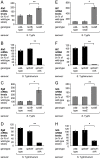
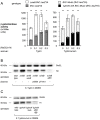
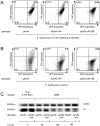
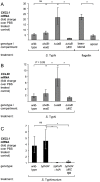
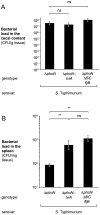
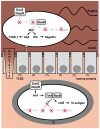
Similar articles
-
Salmonella enterica serovar Typhi impairs CD4 T cell responses by reducing antigen availability.Infect Immun. 2014 Jun;82(6):2247-54. doi: 10.1128/IAI.00020-14. Epub 2014 Mar 18. Infect Immun. 2014. PMID: 24643532 Free PMC article.
-
The flagellar regulator TviA reduces pyroptosis by Salmonella enterica serovar Typhi.Infect Immun. 2015 Apr;83(4):1546-55. doi: 10.1128/IAI.02803-14. Epub 2015 Feb 2. Infect Immun. 2015. PMID: 25644011 Free PMC article.
-
Loss of very-long O-antigen chains optimizes capsule-mediated immune evasion by Salmonella enterica serovar Typhi.mBio. 2013 Jul 16;4(4):e00232-13. doi: 10.1128/mBio.00232-13. mBio. 2013. PMID: 23860765 Free PMC article.
-
Rapid diagnostic tests for typhoid and paratyphoid (enteric) fever.Cochrane Database Syst Rev. 2017 May 26;5(5):CD008892. doi: 10.1002/14651858.CD008892.pub2. Cochrane Database Syst Rev. 2017. PMID: 28545155 Free PMC article.
-
Typhoid fever: "you can't hit what you can't see".Gut Microbes. 2012 Mar-Apr;3(2):88-92. doi: 10.4161/gmic.18602. Epub 2012 Mar 1. Gut Microbes. 2012. PMID: 22156762 Free PMC article. Review.
Cited by
-
Salmonella enterica Serovar Typhimurium Exploits Inflammation to Modify Swine Intestinal Microbiota.Front Cell Infect Microbiol. 2016 Jan 22;5:106. doi: 10.3389/fcimb.2015.00106. eCollection 2015. Front Cell Infect Microbiol. 2016. PMID: 26835435 Free PMC article.
-
The Capricious Nature of Bacterial Pathogens: Phasevarions and Vaccine Development.Front Immunol. 2016 Dec 12;7:586. doi: 10.3389/fimmu.2016.00586. eCollection 2016. Front Immunol. 2016. PMID: 28018352 Free PMC article. Review.
-
A Salmonella Typhi RNA thermosensor regulates virulence factors and innate immune evasion in response to host temperature.PLoS Pathog. 2021 Mar 2;17(3):e1009345. doi: 10.1371/journal.ppat.1009345. eCollection 2021 Mar. PLoS Pathog. 2021. PMID: 33651854 Free PMC article.
-
How to become a top model: impact of animal experimentation on human Salmonella disease research.Infect Immun. 2011 May;79(5):1806-14. doi: 10.1128/IAI.01369-10. Epub 2011 Feb 22. Infect Immun. 2011. PMID: 21343352 Free PMC article. Review.
-
Regulation of virulence: the rise and fall of gastrointestinal pathogens.J Gastroenterol. 2016 Mar;51(3):195-205. doi: 10.1007/s00535-015-1141-5. Epub 2015 Nov 10. J Gastroenterol. 2016. PMID: 26553054 Free PMC article. Review.
References
-
- Zhou D, Galan J. Salmonella entry into host cells: the work in concert of type III secreted effector proteins. Microbes Infect. 2001;3:1293–1298. - PubMed
-
- Tsolis RM, Young GM, Solnick JV, Bäumler AJ. From bench to bedside: stealth of enteroinvasive pathogens. Nat Rev Microbiol. 2008;6:883–892. - PubMed
-
- Parkhill J, Dougan G, James KD, Thomson NR, Pickard D, et al. Complete genome sequence of a multiple drug resistant Salmonella enterica serovar Typhi CT18. Nature. 2001;413:848–852. - PubMed
Publication types
MeSH terms
Substances
Grants and funding
- AI040124/AI/NIAID NIH HHS/United States
- R01 AI044170/AI/NIAID NIH HHS/United States
- R01 AI040124/AI/NIAID NIH HHS/United States
- AI088122/AI/NIAID NIH HHS/United States
- AI076246/AI/NIAID NIH HHS/United States
- R37 AI044170/AI/NIAID NIH HHS/United States
- AI044170/AI/NIAID NIH HHS/United States
- R21 AI079173/AI/NIAID NIH HHS/United States
- R21 AI088122/AI/NIAID NIH HHS/United States
- R01 AI076246/AI/NIAID NIH HHS/United States
- AI073120/AI/NIAID NIH HHS/United States
- R29 AI040124/AI/NIAID NIH HHS/United States
- R21 AI073120/AI/NIAID NIH HHS/United States
- AI079173/AI/NIAID NIH HHS/United States
LinkOut - more resources
Full Text Sources
Other Literature Sources
Molecular Biology Databases

